Pick a spot on a map. Any spot. It can be hundreds or even thousands of miles away and accessible by anything from long stretches of highway to gravel roads, city streets, or freshly laid pavement winding through scenery worthy of an Ansel Adams photograph. Got your spot picked out? Okay, now—quickly—make a list of the bikes that can get you there, comfortably, quickly, and with the electronic wizardry to keep things from getting too interesting along the way. We’re not the gambling type, but we’d bet money that your list is pretty short. We’d also bet that somewhere toward the top of your list you’ve written down Ducati Multistrada.
And for good reason. After all, Ducati's Multistrada has almost since its inception been the best option for riders who like their sportbike performance wrapped up in an adventure-bike guise that enables them to tackle hundreds of unrestrained miles with relative ease. Combine literbike-like horsepower with a competent chassis and an expansive electronics package that includes the recently added semi-active Skyhook suspension, and it's clear why the Multistrada has continually been such a huge success for Ducati.
Of course, it bears mentioning that much of the Multi's success came before BMW pulled the wraps off its new S 1000 XR, a lighter, more sport-oriented adventure-sport bike than the R 1200 GS that the Multistrada had gone up against in years past. So perhaps the question is, even with a newer, more sport-oriented adventure bike to go up against, is Ducati's Multistrada still one of the best bikes for getting you from your driveway to that far-away spot on your map?
To find out, this past month we picked up a map of our own and dropped a pin on a spot where we wanted to go then drew up a route that included everything from long stints on the highway to canyon roads and city streets cutting through sleepy towns. By the time we completed the near-400-mile route on each bike (one complete loop on the Multi and then another on the S 1000 XR), we were pretty sure we had the answer.
Test Notes: BMW S 1000 XR + Great power, smooth delivery + Quick, composed handling - Lack of fine-tuning adjustment for electronics - Vibration in handlebar X Trackday or tour? How about both?
First, a quick look at the competitors: BMW's S 1000 XR is an all-new machine but utilizes an engine not all that different than the one in BMW's S 1000 R roadster, which really is not all that different than the one in its S 1000 RR. The XR's (and R's) cylinder head ports are modified a bit when compared to the RR's, and valve lift is different, though big numbers like bore and stroke are the same. With the XR's more adventurous intentions in mind, however, BMW has developed an all-new aluminum frame and increased structural rigidity of the subframe to accommodate extra cargo. Additionally, when compared to the R, the XR has more rake, more trail (now a whopping 117mm), plus a 65mm-longer swingarm, which contributes to the bike's 109mm-longer wheelbase. Suspension travel is 5.9 inches front and 5.5 inches rear, versus 6.7 inches front and 6.7 inches rear on the Ducati.
Standard features of the XR include ABS, two riding modes (Rain and Road), and ASC (Automatic Stability Control, BMW’s basic traction control system). The optional Pro riding mode makes two additional riding modes available, Dynamic and Dynamic Pro. Both have more aggressive throttle response and include Dynamic Traction Control and ABS Pro, which is BMW’s version of cornering ABS. The XR also comes with BMW’s HP Gear Shift Assist Pro for clutchless shifts in up or down direction, as well as BMW’s semi-active Dynamic ESA (Electronic Suspension Adjustment) as an option.
Bear in mind Ducati is not putting some long-in-the-tooth Multi up against BMW’s new XR, rather a heavily updated version that now features everything from Desmodromic Variable Timing (DVT) engine to a Panigale-culled Inertial Measurement Unit (IMU) that measures roll, pitch, and yaw; a Bosch-Brembo ABS 9.1ME Cornering braking system; cruise control; Ducati Wheelie Control (DWC); Ducati Traction Control (DTC); a 20mm-longer rider seat that’s height adjustable; LCD dashboard; and windshield with new adjustment mechanism that enables 60mm of vertical adjustment.
Still with us? Cool, because on the S model tested here Ducati has made even more updates, not the least of which includes larger, 330mm front brake rotors that clamp onto superbike-culled M50 four-piston calipers (the BMW’s rotors are 320mm); a Ducati Multimedia System (DMS) that enables Bluetooth connection between the bike and a smartphone; Sachs Electronic suspension with semi-active Ducati Skyhook Suspension (DSS); full LED headlights with Ducati Cornering Lights (DCL); forged wheels; and a full-color, 5-inch TFT dashboard. Also on the S model, the new IMU works with the Ducati Skyhook Suspension to enhance its operation, which basically means more performance in any situation you land yourself in.
The semi-active suspension on both the BMW and Ducati continually makes adjustments to compression and rebound damping while riding, though on the Ducati it is possible to adjust base settings for both the fork and shock so that the starting point is closer to how you prefer it. Optional settings for either end include Hardest, Harder, Default, Softer, and Softest, and it's possible to customize each riding mode ahead of time with the settings you'll like to use for different sections of your ride. As an example, we customized Sport mode (one of the four riding modes) with Hardest base settings for the canyon riding we knew we'd be doing, and Touring with Softer base settings for our time on the highway. Along the same lines, we adjusted the eight-level traction control and power delivery as you'd see fit for the extremely diverse riding situations we'd encounter on our route. Creating these custom modes took mere minutes, with the Multistrada's new handlebar switches proving extremely intuitive and the S model's sizable dash making running through menu options rather straightforward. Sure, all of these adjustment options seems extreme, but the benefit of the Multi's system is that once you've spent the 10 minutes to customize each mode, you almost never have to go back and make changes; you've basically got a personalized mode for every type of situation you'll encounter.
Test Notes: Ducati Multistrada 1200 S + Comfortable ergos + Easy-to-adjust screen + Lots of electronic adjustment - Inexplicable flat spot in power curve - Clunky transmission X A new ECU away from winning?
Unfortunately, on the S 10000 XR individual settings for electronic systems cannot be adjusted as freely. For example, power delivery, base suspension settings, and traction control settings for each mode are all preset by BMW engineers, who apparently think they know exactly what engine dynamic and suspension action you’re going to want based on the mode you’re in, with the only option being to shut off traction control or ABS and switch between Dynamic or Road modes for the suspension, Road offering a more plush feel. So German of them…
It’s worth mentioning even still that we liked the overall action of the S 1000 XR’s semi-active suspension and felt like the difference between Road and Dynamic was enough so that Road worked well for highway riding and Dynamic for canyon carving. Similar to what we’ve experienced in our comparison tests between the S 1000 RR and Panigale, there is less of noticeable change in feel as the BMW’s semi-active electronic suspension makes its minute changes to the damping. Combine this more consistent feel from the suspension with a taut German chassis and you have a bike that feels more confidence-inspiring down a twisting section of road and enables you to carry sportbike-like lean angles almost with ease. The BMW also steers into the corner a bit lighter than the Ducati, which also requires just a little more effort to keep cranked over through a corner despite featuring more aggressive rake and trail numbers plus a shorter wheelbase.
Keep in mind, of course, that Ducati’s Multistrada comes standard with enduro-inspired Pirelli Scorpion Trail tires, which have bigger tread blocks for continued performance as you switch over to Enduro mode (another of the bike’s four riding modes) and head off into the dirt. And while these tires do offer more confidence off road than the BMW’s Bridgestone T30 tires, we did notice that after 100-plus miles on twisting paved roads, they began to heat up and squirm, which was cause for lighter inputs at the bar and still more movement at the contact patch. If you don’t plan on hitting the dirt, like ever, then it might not be a bad idea to switch over to more sport-oriented tires, as that might re-establish some confidence on your canyon rides.
Unfortunately, there are still some other things that you are going to have to fix on the Multistrada. Or should we say that Ducati is going to have to fix, as one of the biggest issues with our testbike is a significant flat spot in the bike’s power curves, which is most noticeable between around 3,500 and 6,000 rpm. While Ducati had originally suggested that this could be a result of how the bike’s knock sensor is reacting to US fuels, later statements suggest that it is an issue with the bike’s tune and that they are continually evaluating the problem in hopes of completely smoothing out its power curve. That’s good too, as the resultant flat spot can cause big problems when you’re cruising at around 4,000 rpm, crack the throttle open, and are expecting to accelerate. For us, this happened on the freeway when we were going to pass a car and sometimes as we went to open the throttle while rolling through a long, sweeping corner. In many instances, we’d have to downshift once or twice to get the bike out of the rpm range where the flat spot is most prevalent. In a lot of ways, to us, it feels simply like the bike’s brain is stuttering as it takes information from wheel-speed sensors, a gyro, suspension-travel sensors, this sensor and that, and then tries to give you the “best” performance possible. It’ll be interesting to see what Ducati can do to resolve the issue either way.
The flat spot is a shame too because in all other ways Ducati's DVT engine delivers on its promise, offering smooth fueling in the low rpm range and strong power up top. With the DVT model, we also noticed a slight bump in fuel economy, the newest Multistrada offering up good range over the course of our ride.
Still, the S 1000 XR doesn’t really fall behind in either of these categories. In fact, in regards to the engine, we’d say it’s significantly better. Sure, the inline-four isn’t as character-rich as the Ducati’s admittedly stirring V-twin, but fueling is crisp (if not just a bit soft at initial throttle openings to limit any adverse inputs to the chassis), and the bike builds power so smoothly it’s like you can’t do anything wrong. BMW’s optional HP Gear Shift Assist Pro only adds to the experience, allowing you to work your way up and down through the transmission sans clutch. This, combined with the BMW’s light handling and taut chassis, are a reminder you’re on a superbike turned adventure-sport bike. On the other hand, Ducati’s somewhat clunky transmission (which gifted us a few false neutrals throughout our ride, by the way) combines with its slightly less agile handling to remind you that you’re on more of a touring bike with sporting intent.
And that’s fine, if long-haul comfort and accoutrements like Bluetooth connection is higher on your list of priorities. In this sense, the Ducati does well and goes on to take the cake by offering up a more heavily padded seat, windscreen that is easier to adjust with just one hand, plus a taller one-piece handlebar that doesn’t vibrate quite as frantically as the one on the BMW, which pulsates rather obnoxiously with the engine running at around 5,000 rpm. And, oh, by the way, that’s about where the tach needle sits when you’re rolling 70 mph down the interstate in sixth gear. The vibration through the BMW’s handlebar does dissipate above or below that mark, though by 6,500 rpm (where it really starts to go away) you’re ready to get a ticket.
Aside from the vibration though, the only real thing we can fault the BMW for is its lack of electronic adjustability. And still it offers a fair amount, just not as much as the Ducati. Otherwise, it felt more confidence inspiring, complete, and, most importantly, fun.
Convenient, because assuming that spot you’ve marked on your map is anything more than 400 miles away, you’re going to want something that can keep you entertained along the way. Safe to say, that alone puts the S 1000 XR at the top of our list of bikes that could take us to that spot on our map.
Sport Rider Opinions Kent Kunitsugu Age: 54 Height: 5'8" I really liked the last-generation Multistrada, so I was looking forward to the latest DVT-powered version. Unfortunately, it appears the transition to US specs was troublesome for Ducati because the new Multi has a terrible midrange flat spot. It's too bad because I like the adjustability of the Ducati's suspension compared to the BMW XR, and its ergos fit me better.
The BMW’s engine is a beast, and the chassis and suspension work well. I didn’t go off roading like Bradley, but in all the environments I rode the bike performed admirably. Only some vibration at highway cruising speeds and perhaps a taller sixth gear make the gripes list. If you’re looking for adventure that doesn’t get too serious once the pavement ends, the XR fits the bill.
Bradley Adams Age: 26 Height: 6'3" So, rather naturally, I didn't exactly stick to the route I'd drawn out for this test; if there was a road that looked like it would challenge me, I went for it—paved or not.
The result of that exploring was a real appreciation for the Multistrada S model’s versatility. Between torn-up sections of pavement to graded dirt roads, there wasn’t much the bike couldn’t handle. Sure, I was oft reminded of the bike’s fueling issues, but I’ve got faith in Ducati to resolve that and a few of the other issues that this new model is catching flak for, which includes a seat with stables that pop out and a tripmeter that can get reset when cycling the key. I really do think those problems will be worked out in due time, and in the end you’ll have a great option when shopping for an adventure-sport bike.
Of course, the BMW is good now. No fueling glitches. No electronic quirks. Nothing. It just works really well—almost as if it’s based off one of the best sportbikes on the market. Oh, wait, it is…










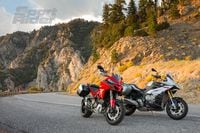
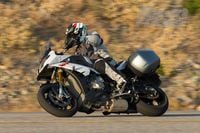
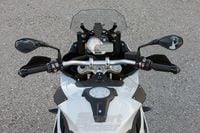
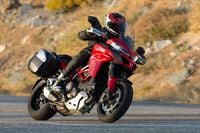
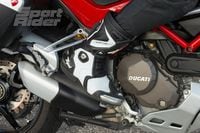
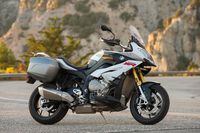
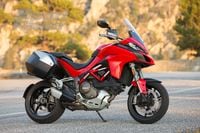
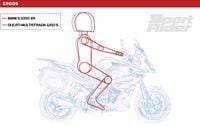
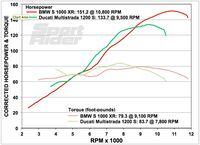
/cloudfront-us-east-1.images.arcpublishing.com/octane/2PLTVHXY7FDSPFHKU5CFOC43ZY.jpg)
/cloudfront-us-east-1.images.arcpublishing.com/octane/B6M3WTRLFZGNXBEATNXPVGBBD4.jpg)
/cloudfront-us-east-1.images.arcpublishing.com/octane/4CMH3FI73BEM5D6MFYX42FLDSQ.jpg)
/cloudfront-us-east-1.images.arcpublishing.com/octane/RIHAPYNWU5H3XAOXNOPRWCBTQA.jpg)
/cloudfront-us-east-1.images.arcpublishing.com/octane/HU4NUBCL3VAFZA75VYRCMAUHVM.jpg)
/cloudfront-us-east-1.images.arcpublishing.com/octane/OB43AZK7TRA6XLZL5WRDVW2TDA.jpg)
/cloudfront-us-east-1.images.arcpublishing.com/octane/5G44Y3FXWNFSTEQKCA355PXOPU.jpg)

/cloudfront-us-east-1.images.arcpublishing.com/octane/XRI4GTLCVBA5NESASCBIR5LYQI.jpg)
/cloudfront-us-east-1.images.arcpublishing.com/octane/EF7566PXARGMBAOMLWTECYL3LE.jpg)
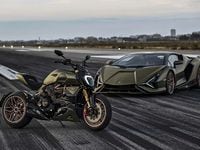
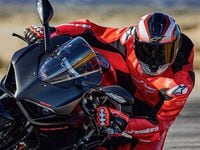

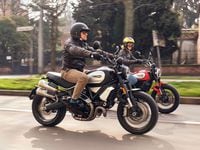

/cloudfront-us-east-1.images.arcpublishing.com/octane/3LASNXSWUZFFPISURDJF3OCWBU.jpg)
/cloudfront-us-east-1.images.arcpublishing.com/octane/2BHJKWUTBNBTLMQCKDNVEG6DKQ.jpg)
/cloudfront-us-east-1.images.arcpublishing.com/octane/MPHXIIV54NAU5L6E4SYZHCXVRM.jpg)



/cloudfront-us-east-1.images.arcpublishing.com/octane/WYXFHF4ZOBBTXELIZDB2FJXU64.jpg)
/cloudfront-us-east-1.images.arcpublishing.com/octane/K5FNV7ONUVDXJJ2H5BIWUGBGTI.jpg)
/cloudfront-us-east-1.images.arcpublishing.com/octane/MGVKP5VTNJHQ7FWNAHIWX4OHO4.jpg)